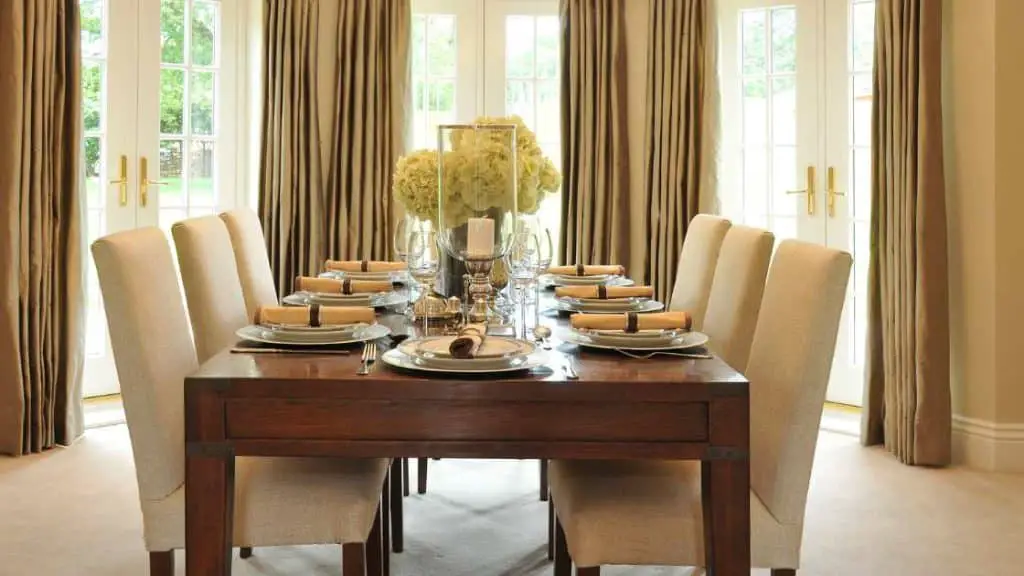To clean an antique dining table, gently wipe with a soft cloth and mild soap. Avoid harsh chemicals and excessive water to protect the finish.
An antique dining table can be the cornerstone of a dining room, bringing a sense of history and elegance to your meals. Such tables often hold great sentimental and financial value, so proper care is essential.
When dealing with these timeless pieces, a delicate touch and the right cleaning techniques are paramount.
Regular dusting can prevent build-up of grime, and when a deeper clean is necessary, one must select the appropriate cleaning agents to maintain the integrity of the wood. Let’s explain in here about “How to Clean Antique Dining Table?”
Following this, a good-quality polish can enhance the table’s natural beauty and provide a protective layer.
Remember, preserving an antique requires attention to detail, a gentle hand, and a commitment to using the right products and methods.
Introduction To Antique Dining Tables
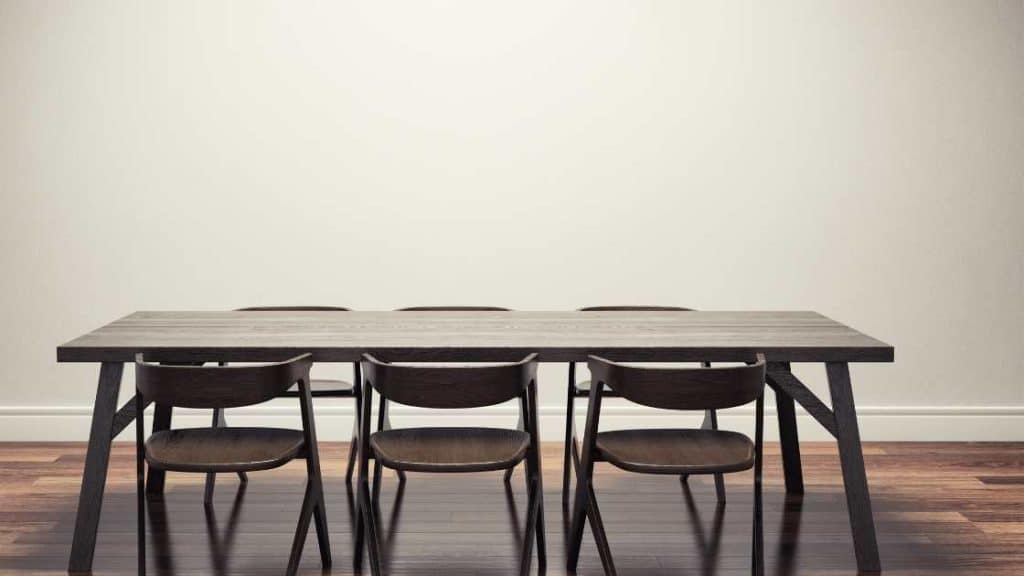
Picture a room graced with the timeless charm of an antique dining table, each detail whispering tales of past soirees and gatherings. Antique dining tables serve as more than mere furniture; they’re a patchwork of history, art, and craftsmanship. These venerable pieces transform meals into occasions and spaces into storied enclaves.
Value And Delicacy Of Antique Furniture
Antique dining tables are treasures with deep historical significance. They often carry intricate designs that modern machinery can’t replicate. Their worth lies not only in their age but also in their ability to withstand the test of time, provided they are well cared for. They are fragile and precious, demanding a gentle touch and specialized care routines.
Preparing To Clean Your Antique Dining Table
Before diving into the cleaning process, it’s essential to prepare carefully:
- Assess the table’s condition.
- Remove any items from its surface.
- Gather soft cloths, gentle cleaners, and soft brushes.
By taking these preliminary steps, you ensure that your antique dining table is treated with the respect and care it deserves. Careful preparation is the key to maintaining its beauty for years to come.
Identifying The Type Of Wood And Finish
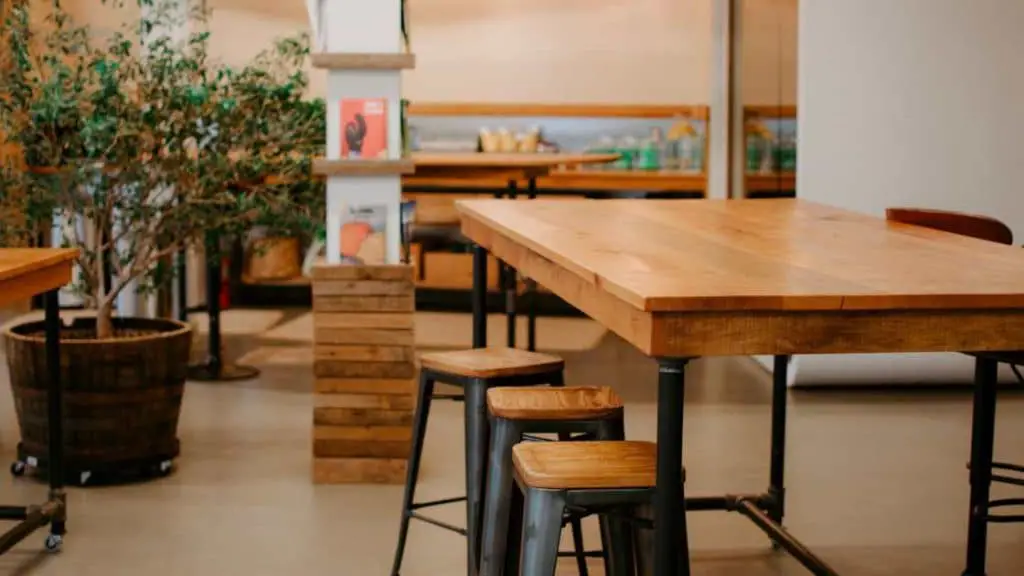
Before diving into the world of restoration, understanding your antique dining table’s heritage is crucial. The wood and finish type set the stage for a careful and appropriate cleaning process.
Characteristics Of Common Woods Used In Antique Tables
Recognizing the wood in your antique dining table enhances both its care and your appreciation of its character.
- Oak: Heavy, strong, with a distinctive grain.
- Mahogany: Rich in color, usually reddish-brown, and highly durable.
- Walnut: Fine-textured and brown, often with a purplish cast.
- Pine: Lighter weight, with a pale finish and prominent knots.
Determining The Type Of Finish: Shellac, Varnish, Or Lacquer
Understanding the finish on your table is essential for selecting the right cleaning method.
- Shellac: Often amber, this finish dissolves in alcohol.
- Varnish: Durable and hard, doesn’t dissolve easily.
- Lacquer: Quick-drying with a sheen, dissolves in lacquer thinner.
To test, apply a small amount of solvent in an inconspicuous area. If the finish softens, you’ve identified it.
Assembling Cleaning Materials
Getting on a journey to lovingly restore your antique dining table’s luster. Assembling the right cleaning materials is vital for maintaining its beauty and integrity.
Select products that are gentle and tools that enhance the cleaning experience, without endangering the delicate wood. Let’s dive into the essentials you’ll need for this delicate task.
Gentle Cleaning Agents Suitable For Antiques
Antique furniture requires specially-formulated cleaners to prevent damage. Keep harsh chemicals away; they can strip away patinas and harm the wood. Choose a mild, pH-neutral soap or a cleaner designed for antiques. Here’s a list of gentle cleaning agents:
- Distilled water: Free of minerals that can deposit onto surfaces.
- Mild detergent: A drop in water will suffice for most cleaning tasks.
- Wood cleaner: Pick a product tailored for antique woods.
- Baby wipes: Unscented and gentle for quick dust removal.
- Microcrystalline wax: To nourish the wood after cleaning.
Essential Tools For A Safe Cleaning Process
Now that your cleaning agents are ready, assembling the right tools will ensure a safe and effective cleaning process. Utilize these to protect your antique’s finish:
- Soft cloths: For applying cleaners and buffing surfaces.
- Nylon brushes: To reach into nooks and crannies without scratching.
- Cotton buds: Ideal for cleaning detailed areas.
- Sponge: A non-abrasive one for washing with mild detergent.
- Rubber gloves: To protect your hands and the wood from natural oils.
| Tool | Use Case |
|---|---|
| Soft cloths | Applying and buffing |
| Nylon brushes | Cleaning crevices |
| Cotton buds | Detail work |
| Sponge | Mild washing |
| Rubber gloves | Protection for hands |
The Initial Cleaning Process

The Initial Cleaning Process is a delicate endeavor that breathes new life into your antique dining table. It sets the stage for preserving the beauty of the piece. Proper care ensures the table remains a cherished centerpiece for years to come.
Dusting: The First Step To A Spotless Table
Dusting is crucial in maintaining the table’s intricate details. Use a soft, microfiber cloth or a gentle brush to lift away loose particles. Clean in the direction of the wood grain to avoid scratches. Performing this task regularly minimizes abrasive build-up.
Assessing The Table For Specific Cleaning Needs
Every antique table has its unique characteristics. Look closely for any sticky residues or stains. Identify areas needing extra attention, like carvings or inlaid details. Choose the appropriate cleaning agents that are safe for the wood’s age and finish.
- Wax Build-up: Use a diluted vinegar solution to dissolve old wax gently.
- Oil and Grime: A mild soap and water mixture can tackle tougher spots.
- Water Rings: An application of non-abrasive toothpaste might be the remedy.
Dealing With Superficial Stains And Spills
An antique dining table can truly be the centerpiece of a room, bringing with it a sense of history and elegance. But along with its beauty come the inevitable spills and stains due to daily use or accidental mishaps.
Fear not, when it comes to dealing with superficial stains and spills, a little know-how is all you need to restore your table’s splendor without causing damage.
Homemade Solutions For Gentle Cleaning
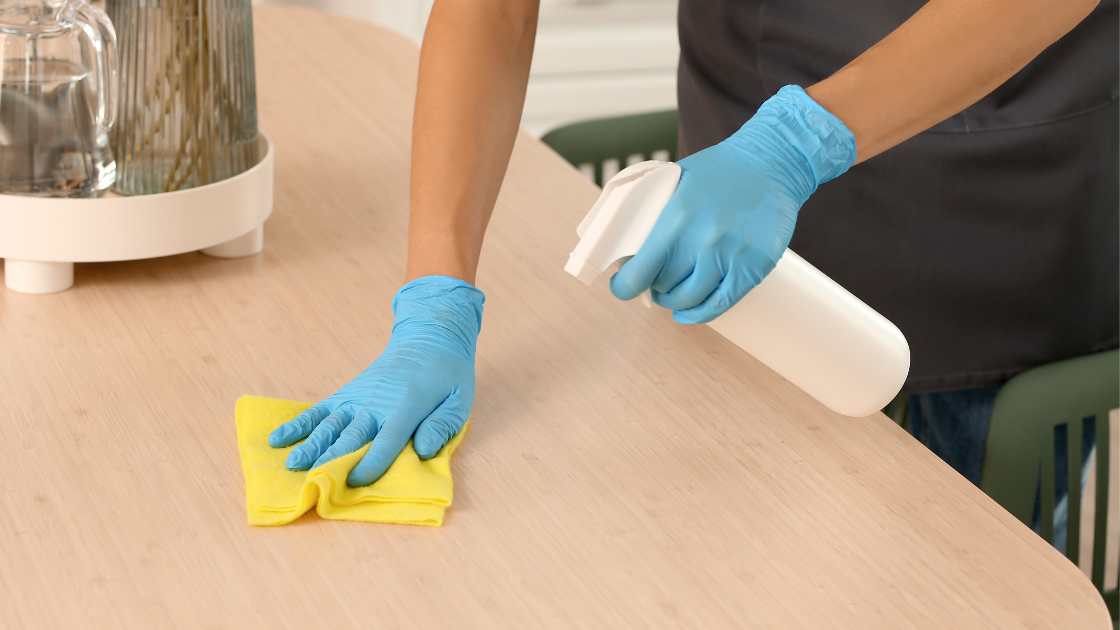
Before reaching for harsh chemicals, try gentle, homemade solutions that are kind to your antique wood. Mix water with a mild dish detergent for an effective, gentle cleaning mixture. Use a soft, lint-free cloth, dampened with the solution, to wipe the surface of the table. Be sure to follow with a dry cloth to remove any moisture.
For tougher grime, a paste made from equal parts of water and baking soda can do the trick. Apply the paste gently with a soft cloth, then rinse with a damp cloth and dry immediately. It is essential to avoid over-saturating the wood, which can cause damage.
Techniques For Tackling Water Rings And Heat Marks
Water rings and heat marks are common issues that can mar an antique table. Use a mixture of non-gel toothpaste and baking soda to gently rub the affected area with a soft cloth. Rinse with a damp cloth and dry right away.
If the stain persists, you may need to escalate to a more powerful solution. Mix a solution of one part vinegar to one part olive oil and apply it to the stain with a soft cloth. This mixture can help diminish the appearance of water rings and heat marks while also nourishing the wood.
Another method includes using fine-grade steel wool dipped in lemon oil. Rub the affected area very gently along the grain of the wood. Always finish by buffing with a clean, dry cloth to shine.
Deep Cleaning – When And How
Caring for an antique dining table means knowing when it needs a deep clean. Such a clean preserves its beauty and value. Deep cleaning removes built-up dirt and grime that daily cleaning can’t tackle. It should happen with care to avoid damaging the wood.
Identifying Situations That Require Deep Cleaning
Several signs indicate your table needs deep cleaning. Look for these:
- Visible dirt in wood grain
- Dull or sticky surface
- Old wax or polish residue
After parties or holiday dinners, a table may need extra attention. High humidity or extended storage also call for deep cleaning. If your table shows these signs, it’s time for a deeper clean.
Methods For Deep Cleaning Without Damaging The Wood
Deep cleaning must be done without harming the antique wood. Here’s how to ensure safety:
- Dust first to remove loose particles.
- Make a gentle cleaner with water and mild dish soap.
- Use a soft cloth dipped in the solution, wring it out well.
- Wipe the table gently, following the wood grain.
- Rinse with a damp cloth, using only water.
- Dry immediately with a soft towel.
For stubborn grime, use a soft toothbrush with the same solution. Do not soak the wood. Test any cleaner on a small area first.
| Cleaning Step | Instructions |
|---|---|
| Preparation | Dust with microfiber cloth. |
| Cleaning Mixture | Combine water and mild soap. |
| Cleaning Process | Clean with a soft cloth, rinse, and dry. |
| Spot Cleaning | Use a soft toothbrush on tough spots. |
Use lemon oil or wax sparingly after cleaning for shine and protection. Always remember, treat your antique dining table with the gentle touch it deserves.
Repairing Minor Scratches And Dents
Antique dining tables often tell a story through the scratches and dents they have acquired over the years. While these marks add character, some prefer to keep their treasures in pristine condition.
We’ll explore the gentle art of repairing minor scratches and dents, preserving the integrity and beauty of your unforgettable piece.
Diy Tips For Addressing Superficial Damage
Tackling minor damage on your antique dining table is a task you can proudly do at home with the right tools and methods. Here’s how to erase those little reminders of the past:
- Clean the Area: Begin with a soft, damp cloth to remove any dirt.
- Wax Sticks: For minor scratches, color-matched wax sticks can work wonders.
- Walnut Trick: Gently rub a walnut over the scratch, as the oils can help mask it.
- Sanding: Lightly sand the area with fine-grit sandpaper if necessary.
- Final Touch: Finish with a polish using a clean, dry cloth for shine.
When To Call A Professional Restorer
Some damage requires an expert touch. Know when to seek professional help:
| Damage Type | DIY or Professional |
|---|---|
| Deep Scratches | Professional |
| Chipped Wood | Professional |
| Severe Discoloration | Professional |
| Structural Damage | Professional |
Restorers can match colors and grains with near-perfect accuracy. They ensure the repair blends seamlessly with your table’s historical character.
Polishing And Buffing Your Antique
Caring for your antique dining table involves more than just a clean cloth and a quick wipe. Polishing and buffing are critical steps in maintaining the lustrous shine and historic charm of your treasured piece. A well-maintained table can be the centerpiece of a room, drawing eyes and starting conversations.
The process, when done correctly, not only enhances appearance but also protects the wood from damage. Let’s delve into the art of picking the perfect polish and mastering the wax and buff technique to keep your antique in tip-top shape.
Choosing The Right Polish For Your Antique Table
Selecting the ideal polish requires your table’s wood type and finish. Some polishes work best on certain wood species. Others are formulated for specific finishes like varnish, shellac, or lacquer. Be sure to consult an expert or do your homework before making a choice.
- Opt for quality over quantity.
- Avoid products with silicone or harmful chemicals.
- Consider natural beeswax polish for a gentle, effective treatment.
The Correct Way To Apply Wax And Buff The Surface
Applying wax correctly ensures protection and shine. Follow these steps for the best results:
- Gather a clean, lint-free cloth.
- Apply a small amount of wax to the cloth.
- In a circular motion, spread the wax evenly.
- Let it dry to a haze as per the product instructions.
After the wax hardens, buffing brings out the shine:
- Use a clean, soft cloth or brush.
- Buff in a circular motion for an even sheen.
- Repeat if needed, increasing pressure gradually.
Attention to detail will leave your antique dining table gleaming. Be patient, and enjoy the process as your furniture’s beauty unfolds with each buff.
Maintaining Antique Dining Tables Long-term
Maintaining your antique dining table requires more than a quick polish. To ensure its longevity and preserve its beauty, a dedicated care routine is paramount. Here’s how to keep your cherished furniture in top condition for years to come.
Regular Upkeep To Prevent Damage
Consistent maintenance is the key to protecting your antique wood from wear and tear. Follow these simple steps:
- Dust weekly using a soft, dry cloth to avoid buildup.
- Clean spills immediately to prevent staining or warping.
- Apply wax every few months to create a protective layer.
- Avoid harsh chemicals that can strip away finishes and damage wood.
Environmental Factors That Affect Antique Wood
Environmental conditions can greatly impact your antique dining table’s integrity. Keep these factors in mind:
| Factor | Preventive Action |
|---|---|
| Humidity | Use a dehumidifier to maintain stable levels. |
| Sunlight | Position away from direct rays or use UV-filtering curtains. |
| Temperature | Avoid placing near heat sources to prevent cracking. |
| Insects | Inspect regularly and treat if needed with mild, wood-safe products. |
Addressing The Environment: Humidity And Temperature
Cleaning your antique dining table requires more than just polish. Environment control is crucial. Humidity and temperature can make or break antique wood. Learn the secrets to protect and maintain your timeless piece.
The Impact Of Humidity On Antique Wood
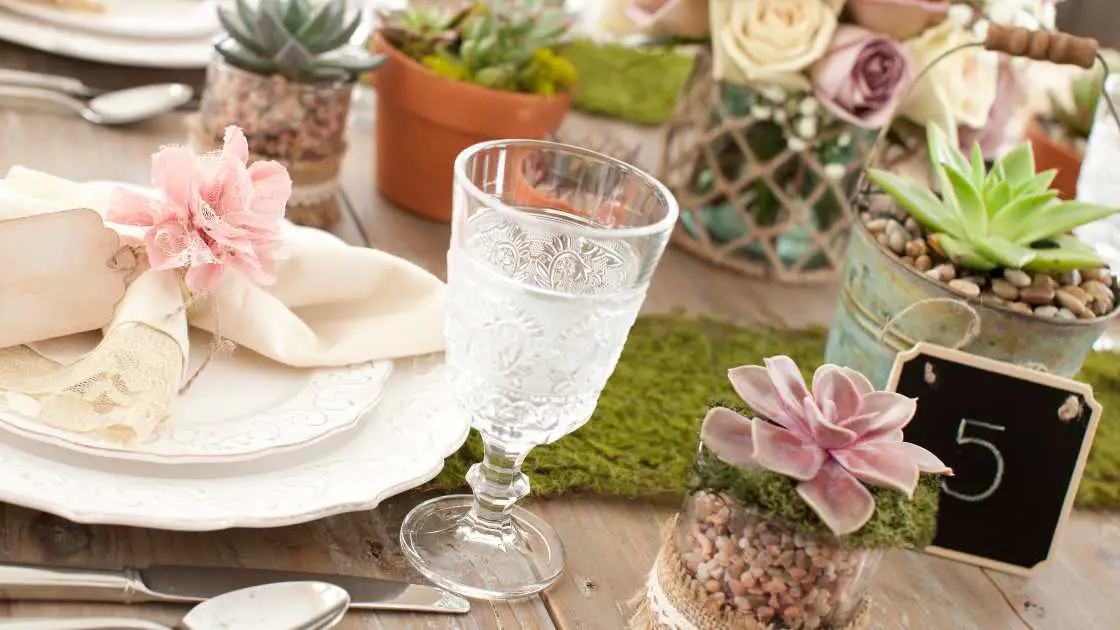
High humidity swells wood, while low levels cause it to crack. Keeping a balance is key for your table.
- Use humidifiers or dehumidifiers depending on need
- Monitor levels with a hygrometer
- Keep consistency to prevent damage
Maintaining Consistent Temperature For Preservation
Extreme temperatures wreak havoc on antique woods. A steady environment prolongs life. Avoid placing your table near heat sources or in direct sunlight.
| Season | Temperature Range |
|---|---|
| Winter | 65-70°F (18-21°C) |
| Summer | 75-80°F (24-27°C) |
Consider insulated curtains to stabilize room temperature.
Smart thermostats can help maintain a perfect balance. Avoid sudden changes that can shock the wood.
Enjoying Your Clean Antique Dining Table
Now that your antique dining table shines with cleanliness, you can truly appreciate the beauty of your cherished piece. The gentle care taken can be seen in the wood’s luster.
The Rewards Of Proper Care For Your Antique Table
Maintaining your antique dining table is rewarding. Every polished corner tells a story. With each gentle cleanse, you:
- Protect the wood from damage.
- Uphold the table’s value for further years.
- Enhance its aesthetic appeal, making it a centerpiece.
Seeing your table restored to its original glory is a testament to your dedication. It stands not just as a functional item but as a piece of history in your home.
Passing On The Legacy Of An Antique
Your antique dining table is more than wood and nails. It is a legacy. By taking care of it:
- You honor past craftsmanship.
- Share stories and memories with loved ones.
- Pass a piece of heritage to future generations.
Cleaned and cared for, your table is ready for countless more gatherings, celebrations, and everyday moments. Its graceful aging under your care will continue to inspire and add charm to your home.
Frequently Asked Questions On How To Clean Antique Dining Table
What’s The Best Cleaner For Antique Dining Tables?
The ideal cleaner for antique dining tables is a gentle, non-abrasive solution. Use mild dish soap diluted in water, and apply with a soft cloth. Avoid harsh chemicals that can strip the finish or damage the wood.
Can Lemon Oil Be Used On Antique Wood Tables?
Yes, lemon oil can be used on antique wood tables, but sparingly. It’s a natural conditioner that can nourish the wood and enhance its shine. Apply a small amount with a soft cloth, and polish gently to avoid saturating the wood.
How Often Should You Dust An Antique Dining Table?
Dust your antique dining table at least once a week. Regular dusting prevents buildup that can scratch the table’s surface. Use a soft, lint-free cloth to avoid damaging the wood or the finish.
What’s The Safest Way To Remove Stains From Antique Tables?
The safest way to remove stains from antique tables is to mix a paste of baking soda and water. Gently rub the paste on the stain, then wipe it off with a damp cloth. Always test a small, inconspicuous area first.
Can You Clean Antique Wood With Vinegar?
Yes, you can clean antique wood with vinegar, as it serves as a gentle and natural option for removing dirt and grime without causing damage to the delicate surface. However, it’s essential to dilute the vinegar with water and test a small, inconspicuous area first to ensure it won’t negatively impact the wood’s finish.
Conclusion
Caring for your antique dining table preserves its elegance and value. Regular, gentle cleaning with the right methods ensures a lasting shine. Remember, the beauty it brings to your home is worth the effort. Cherish your piece by keeping it in pristine condition for future generations to admire.

